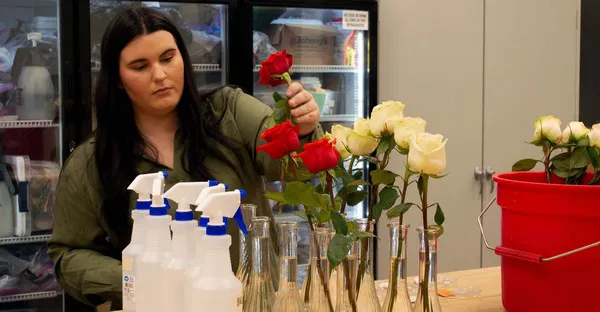This weekend, mothers all over the nation will receive bouquets of flowers for their special day. But what if you could give mom flowers she could enjoy day and night?
Researchers in the Oklahoma State University Department of Horticulture and Landscape Architecture are studying how flowers can shine as bright in the night as they do in the daytime.
"I've always had an interest in glow-in-the-dark plants," Professor Bruce Dunn said. "When you receive a flower arrangement, you only get to enjoy it for 10 to 14 days, so you should get to see it during the day and at night. This quality would give it increased value."

Abby Pace, an OSU undergraduate student who entered the Horticulture Research and Extension Experience for Undergraduates program during her sophomore year, was given the task of researching how white carnations could glow in the dark.
"No one has really done anything related to glow-in-the-dark applications," Dunn said. "When you tint a flower, you increase its economic value, but most tinting that has been done to flowers has just been normal coloring of flowers. We wanted to achieve that glow-in-dark factor."
Giving flowers a glow-in-the-dark quality is normally done through gene therapy, which is expensive. Dunn said the closest thing he and Pace found to their study was a research project on root uptake with beets that gave them a slight glow.
"I knew I wanted to do a greenhouse study. Dr. Dunn had two different studies, and I was selected for this one. So, it kind of chose me, but I've been really excited about it," Pace said. "It's an interesting topic, and I have been happy to be part of this research."
In fact, Pace was so passionate about her research that it turned into three research projects over the course of two years.
Pace and Dunn found that flowers uptaking glow-in-the-dark substances through their roots did not give them a strong enough glow, so they moved on to topical methods, such as spray paint and highlighter markers. They found that the spray paint worked to give the glow-in-the-dark effect, while the highlighters did not. But glow-in-the-dark spray paint only comes in green, so Pace tried glow-in-the-dark powder mixed in water.
Now, as a senior for her Honors College project, Pace is applying red, orange, white, green, and blue phosphorescent powder topically to the petals of red and white roses.
"When you get a bouquet of flowers, you don't usually get all white flowers; you get them in different colors," Pace said. "We decided to see how each of the colors showed up on darker-colored flowers. That's where the red roses and the additional colors came in."
Pace said their research has found that powder is the best method to achieve a glow. The red powder gave no glow to the roses, while the blue and green powders gave the strongest glow. The white roses emitted the brightest glow.
"In all the studies, we found that exposure to ultraviolet light increases the glow," Pace said. "After charging the flowers with the light, the glow of the flowers was really enhanced."
Dunn added the method didn't deteriorate the flowers' quality, either.
"You still get ten days out of the flowers," Dunn said.
Pace took her research one step further. She took pictures of the flowers, then analyzed them through a computer program to see what the RGB values of the colors were. She then used a computer program to convert those values into wavelengths. This told the researchers which color in the picture was more dominant, allowing them to determine in another way which colors had a stronger glow.
Pace's research was published in the prominent scientific magazine HortScience last year.
"There has been a lot of learning and growth for me over the three years of this research. Once I learned the process of research, I realized it was not as intimidating as it appeared to be," Pace said. "This research has made me want to continue my education and go on to graduate school. It has been a great experience."
Source: agresearch.okstate.edu
